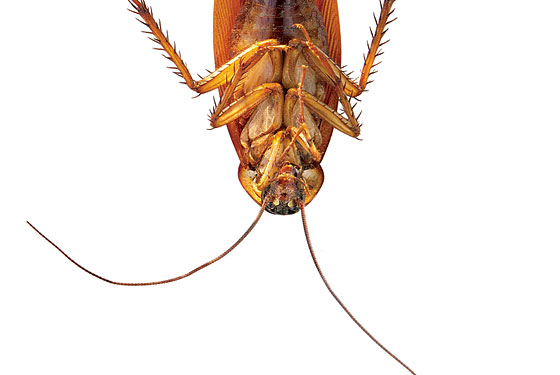
Whether you have cockroaches depends on not only how clean you keep your apartment but also how clean your neighbors are. Since apartments in the same vertical line tend to have the same layout, and New York’s German cockroaches travel along pipes and wires, you’re more likely to get invaded if someone living above or below you has them; your kitchens are touching. Roaches are attracted by food and water, but just washing your plates and fixing leaky faucets isn’t going to keep them at bay. “We are pretty disgusting animals,” says exterminator Matthew Hill of Paul’s A-Z Services, referring to humans, “and roaches love everything about us, from our backed-up drains to our overflowing trash cans.” Keep an eye on the details: dishwasher hinges, exposed water pipes, the underside of stove knobs where food collects, and pet-food dishes, for example. The dark crevices of coffeemakers, toasters, and microwaves attract roaches, so unplug these appliances and vacuum them regularly. The bugs can live off paper, so recycle newspapers and boxes. And don’t line cabinets with contact paper: Roaches will eat the glue and use the area between the paper and the shelf to breed.
WHAT TO DO IF YOU’VE GOT THEM
Before grabbing the poison, look around. “Exterminators today have forgotten the No. 1 most important tool of the trade: the flashlight,” says Matthew Hill. Look under the sink and in the corners of cabinets and pantries for bugs, feces (dark smudges and dots), and egg cases (yellowish, crenulated, fingernail-size). Clean up the remnants using gloves and antibacterial soap. Also check wooden furniture, one of the creature’s favorite hideouts. “You’re looking for what resembles two eyelashes dancing out from the wood, usually where the leg meets the table,” Hill says. “Those are the antennae, looking for food nearby.” Once you’ve found as many roach homes as you can, take action. Hill recommends applying dots of roach gel onto wood; for approaches to other surfaces, see the chart at right. But don’t stop there. Insecticide will kill the roaches you have, but to keep them out for good, you’ll need to seal every crack in the kitchen and bathroom with 100 percent silicone caulk, which lasts up to twenty years. Some supers will do this for free; you can do it yourself with a caulking gun from the hardware store. Or you can hire an exterminator, who will do the job for about $200 to $300. Cracks and holes are commonly found around sink pipes; behind the stove, where the gas line enters the apartment; around windows; where the wall meets the floor and cabinets meet the wall; around radiators and radiator pipes; and around the tub or shower. This process typically takes an exterminator one to three hours, so block off a full afternoon if you do it yourself.
Pick Your Poison
Cockroaches build up resistance to pesticides—and pass on that resistance to their offspring. So use multiple kinds.
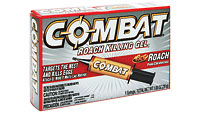
BORIC ACID
How to Apply:In a very thin, barely visible layer around the edges of the room and in cracks; roaches will avoid piles of powder.
How it Works:Roaches walk through the powder, ingest it while grooming, and die three to seven days later.
When to Replace:After sweeping or mopping, or if the powder gets wet.
Advantages: Long lasting and inexpensive.
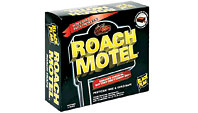
BAITS
How to Apply:Place flush against the wall under sinks, toilets, and appliances and near the trash.
How it Works:Same as above: Bait attracts roaches, they eat it, go home, and die. Other roaches eat them and die in turn.
When to Replace:Every three months, or when the shell is empty. Write the date you opened it on the bottom.
Advantages: There’s almost no chance of a child or pet ingesting the totally enclosed poison.
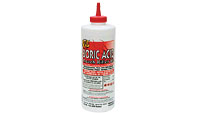
ROACH GEL
How to Apply:As sparingly as possible—a pea-size dot, deep in cracks and door hinges, will suffice.
How it works:Roach eats gel, hobbles home, and dies about an hour later. Other roaches eat it and die. One roach can kill 30 or 40 others.
When to Replace:Two weeks to a month.
Advantages: A very small amount of poison kills a lot of roaches—and fast.
SEE ALSO:
• Battling Bedbugs
• Eradicating Mice or Rats
• Meet the Experts
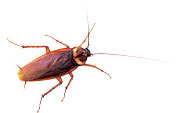
The American Cockroach
Don’t be (as) frightened.
The American cockroach—also called the water bug—is bigger than the German variety but doesn’t congregate in groups like they do. (If you see a few German roaches, you can be almost completely certain that hundreds are nearby. Gross and terrifying, but true.) Americans typically prefer sewers and basements and only come upstairs in summer humidity. They can be killed with the same insecticides as their German brethren. But since they’re loners, treat-every-crack assaults are not usually necessary.
Photo: Dorling Kindersley/Getty Images